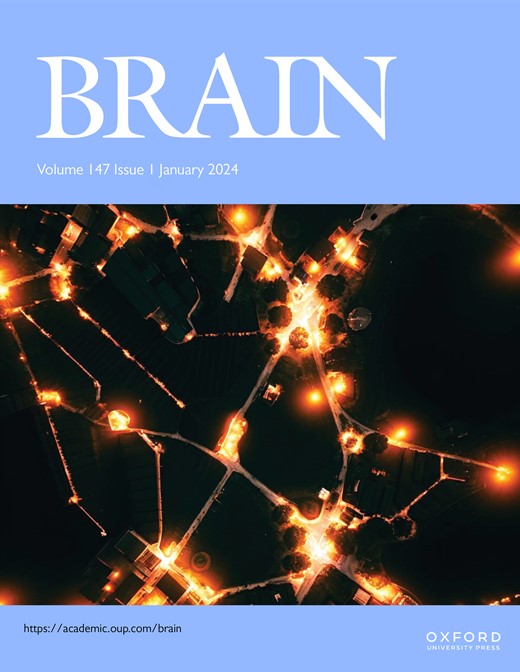Brain regulation of pulmonary dysfunction induced by stroke
IF 11.7
1区 医学
Q1 CLINICAL NEUROLOGY
引用次数: 0
Abstract
Ischemic stroke, characterized with sterile brain tissue injury, can lead to an acute pneumonia and pulmonary dysfunction, which are the primary causes of death in ischemic stroke patients. The neural and molecular mechanisms association between the infarcted brain area and the development of pneumonia and pulmonary dysfunction are not understood. We used the whole-body plethysmography, respiratory patterns test and arterial blood gas analysis to examine pulmonary function. In addition, holter monitoring, electrophysiological recordings, chemogenetic manipulation, fiber photometry, ELISA, immunofluorescence, Western blotting, RT-qPCR, HE staining, TUNEL staining and viral-mediated manipulations were used to address our questions. Here, we observed significant pneumonia (immune cells infiltration and inflammatory cytokines increases) and pulmonary dysfunction in middle cerebral artery occlusion rats. A decrease in parasympathetic nerve function and activity was observed in clinical patients and rodent models with acute ischemic stroke. Mechanistically, ischemic stroke leads to the apoptosis of glutamatergic neurons in the paraventricular nucleus of the hypothalamus (PVNCaMKII) that innervate acetylcholine neurons in the dorsal motor nucleus of the vagus (DMVACh), and subsequently decreases the activity of DMVACh neurons. The reduced DMVACh neurons activity, via α7 nicotinic acetylcholine receptor (α7nAChR), upregulates high mobility group box 1 (HMGB1) expression in the pulmonary parasympathetic ganglia neurons, which increases the expression of tumor necrosis factor-alpha and interleukin-1beta in various immune cells via the Toll-like receptor 4 (TLR4) or receptor for advanced glycation end products (RAGE). Meanwhile, the activation of circuit from DMVACh neurons to pulmonary parasympathetic ganglia neurons improved the pneumonia and pulmonary dysfunction. These results dissect a novel neuroimmune framework that acute ischemic stroke induces the apoptosis of DMVACh-innervating PVNCaMKII neurons, and subsequently promotes the immune cells infiltration and inflammatory cytokines increases by acting on the α7nAChR-HMGB1 pathway in the pulmonary ganglion neurons, which leads to pulmonary dysfunction. These provided a novel insight on the pathogenesis of pneumonia and pulmonary dysfunction after acute ischemic stroke.脑调控脑卒中所致肺功能障碍
缺血性脑卒中以无菌性脑组织损伤为特征,可导致急性肺炎和肺功能障碍,这是缺血性脑卒中患者死亡的主要原因。脑梗死区与肺炎和肺功能障碍发展之间的神经和分子机制尚不清楚。我们采用全身体积脉搏图、呼吸模式试验和动脉血气分析来检查肺功能。此外,动态监测、电生理记录、化学发生操作、纤维光度法、ELISA、免疫荧光、Western blotting、RT-qPCR、HE染色、TUNEL染色和病毒介导的操作都被用来解决我们的问题。我们观察到大脑中动脉闭塞大鼠明显的肺炎(免疫细胞浸润和炎性细胞因子增加)和肺功能障碍。在急性缺血性脑卒中的临床患者和啮齿动物模型中观察到副交感神经功能和活动的下降。从机制上说,缺血性卒中导致下丘脑室旁核谷氨酸能神经元(PVNCaMKII)凋亡,这些神经元支配迷走神经背运动核乙酰胆碱神经元(DMVACh),从而降低DMVACh神经元的活性。DMVACh神经元活性降低,通过α7烟碱乙酰胆碱受体(α7nAChR)上调肺副交感神经节神经元高迁移性组盒1 (HMGB1)的表达,从而通过toll样受体4 (TLR4)或晚期糖基化终产物受体(RAGE)增加各种免疫细胞中肿瘤坏死因子- α和白细胞介素-1 β的表达。同时,DMVACh神经元到肺副交感神经节神经元回路的激活改善了肺炎和肺功能障碍。这些结果揭示了一个新的神经免疫框架,即急性缺血性卒中诱导支配dmvach的PVNCaMKII神经元凋亡,进而通过作用于肺神经节神经元α7nAChR-HMGB1通路促进免疫细胞浸润和炎症因子增加,从而导致肺功能障碍。这些为急性缺血性脑卒中后肺炎和肺功能障碍的发病机制提供了新的见解。
本文章由计算机程序翻译,如有差异,请以英文原文为准。
求助全文
约1分钟内获得全文
求助全文
来源期刊

Brain
医学-临床神经学
CiteScore
20.30
自引率
4.10%
发文量
458
审稿时长
3-6 weeks
期刊介绍:
Brain, a journal focused on clinical neurology and translational neuroscience, has been publishing landmark papers since 1878. The journal aims to expand its scope by including studies that shed light on disease mechanisms and conducting innovative clinical trials for brain disorders. With a wide range of topics covered, the Editorial Board represents the international readership and diverse coverage of the journal. Accepted articles are promptly posted online, typically within a few weeks of acceptance. As of 2022, Brain holds an impressive impact factor of 14.5, according to the Journal Citation Reports.
 求助内容:
求助内容: 应助结果提醒方式:
应助结果提醒方式:


